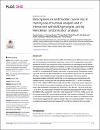Blood pressure and bladder cancer risk in men by use of survival analysis and in interaction with NAT2 genotype, and by Mendelian randomization analysis
| Author | Teleka, Stanley |
| Author | Hindy, George |
| Author | Drake, Isabel |
| Author | Poveda, Alaitz |
| Author | Melander, Olle |
| Author | Liedberg, Fredrik |
| Author | Orho-Melander, Marju |
| Author | Stocks, Tanja |
| Available date | 2021-01-31T09:03:30Z |
| Publication Date | 2020-11-01 |
| Publication Name | PLoS ONE |
| Identifier | http://dx.doi.org/10.1371/journal.pone.0241711 |
| Citation | Teleka S, Hindy G, Drake I, Poveda A, Melander O, Liedberg F, et al. (2020) Blood pressure and bladder cancer risk in men by use of survival analysis and in interaction with NAT2 genotype, and by Mendelian randomization analysis. PLoS ONE 15(11): e0241711. https://doi. org/10.1371/journal.pone.0241711 |
| Abstract | The association between blood pressure (BP) and bladder cancer (BC) risk remains unclear with confounding by smoking being of particular concern. We investigated the association between BP and BC risk among men using conventional survival-analysis, and by Mendelian Randomization (MR) analysis in an attempt to disconnect the association from smoking. We additionally investigated the interaction between BP and N-acetyltransferase-2 (NAT2) rs1495741, an established BC genetic risk variant, in the association. Populations consisting of 188,167 men with 502 incident BC's in the UK-biobank and 27,107 men with 928 incident BC's in two Swedish cohorts were used for the analysis. We found a positive association between systolic BP and BC risk in Cox-regression survival analysis in the Swedish cohorts, (hazard ratio [HR] per standard deviation [SD]: 1.14 [95% confidence interval 1.05-1.22]) and MR analysis (odds ratio per SD: 2-stage least-square regression, 7.70 [1.92-30.9]; inverse-variance weighted estimate, 3.43 [1.12-10.5]), and no associations in the UK-biobank (HR systolic BP: 0.93 [0.85-1.02]; MR OR: 1.24 [0.35-4.40] and 1.37 [0.43-4.37], respectively). BP levels were positively associated with muscle-invasive BC (MIBC) (HRs: Systolic BP, 1.32 [1.09-1.59]; diastolic BP, 1.27 [1.04-1.55]), but not with non-muscle invasive BC, which could be analyzed in the Swedish cohorts only. There was no interaction between BP and NAT2 in relation to BC on the additive or multiplicative scale. These results suggest that BP might be related to BC, more particularly MIBC. There was no evidence to support interaction between BP and NAT2 in relation to BC in our study. |
| Language | en |
| Publisher | Public Library of Science |
| Subject | Blood Pressure Bladder Cancer Mendelian Randomization |
| Type | Article |
| Issue Number | 11 November |
| Volume Number | 15 |
Files in this item
This item appears in the following Collection(s)
-
Medicine Research [1633 items ]


